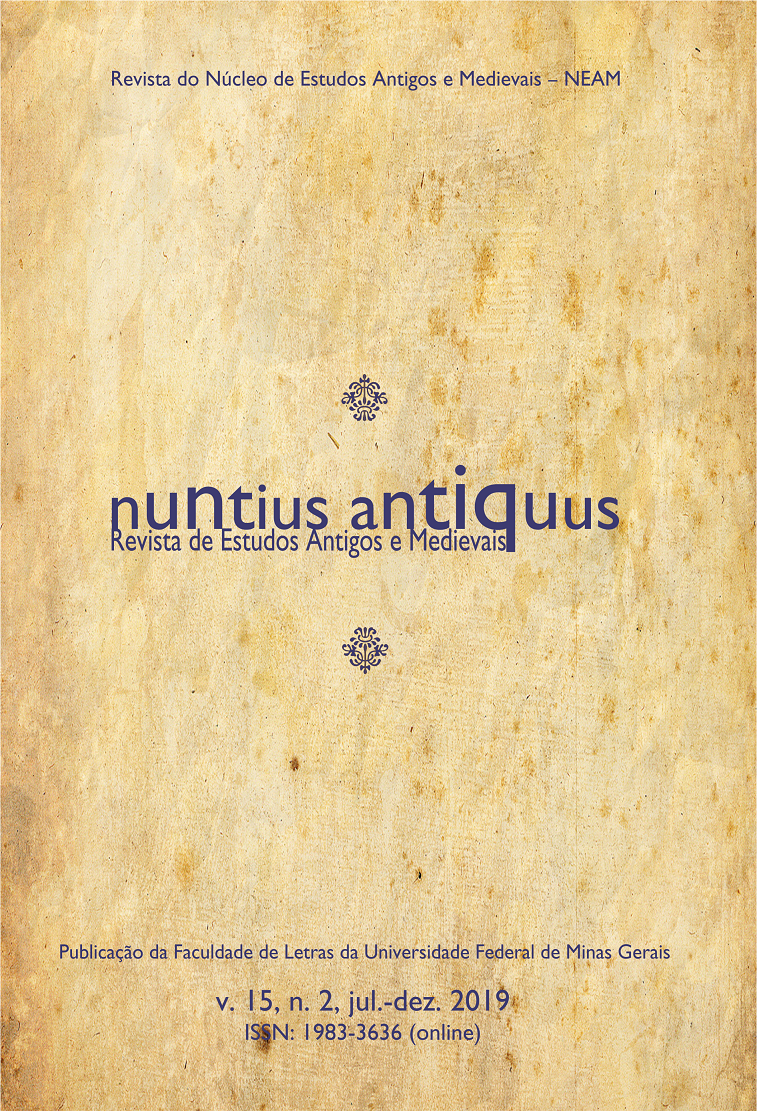The Representation of the Feminine and the Juridical Status of Women in “The Matron of Ephesus” and “The Lover in the Jug”
Keywords:
Law and literature, literature and history, classical literature, ancient Roman novel, Petronius, ApuleiusAbstract
This article aims to explore the representation of the feminine and the social and juridical status of women by means of the analysis of two short stories from the ancient Roman novel. The first, “The Matron of Ephesus”, is inserted in the context of Satyricon of Petronius, and the second “The Lover in the Jug” present in The Golden Donkey of Apuleius. The research is rooted in the modern theoretical aspects of intertextuality and Bakhtinian dialogism. It also draws some of its theoretical points from the interface between law and literature, as well as literature and history. It addition, it takes advantage of the contributions coming from the archaeological findings in the city of Pompeii, which can further broaden the horizon of the knowledge about the selected literary corpus, revealing hidden lines of thought and important questions about the women’s social position and the practice of adultery in the Rome of Petronius and Apuleius.
Downloads
References
APULEIO. O burro de ouro. Tradução de Delfim Leão. Lisboa: Livros Cotovia, 2007.
BAKHTIN, M. Problemas da poética de Dostoiévski. Tradução de Paulo Bezerra. Rio de Janeiro: Forense Universitária, 1981.
BAKHTIN, M. Questões de literatura e de estética: A Teoria do Romance. Tradução de Aurora Fornoni Bernadini. São Paulo: Edunesp, 1998.
BOCCACCIO, G. Decamerão. Tradução de Torrieri Guimarães. São Paulo; Abril Cultural, 1971.
BONFANTE, L. Introduction. In: SEBESTA, J. L.; BONFANTE, L. The World of Roman Costume. University of Wisconsin Press, 2001. p. 7.
BRANDÃO, J. L. A invenção do romance. Brasília: Ed. Universidade de Brasília, 2005.
CAVICCHIOLI, M. R. Fama e infâmia na sexualidade romana. Romanitas: Revista de Estudos Grecolatinos, Vitória, n. 3, p. 153-169, 2014.
CUEVA, E. P.; BYRNE, S. N. Companion to the Ancient Novel. Oxford: John Wiley & Sons, 2014. DOI: https://doi.org/10.1002/9781118350416.
FEITOSA, L. C. Gênero e Sexualidade no mundo romano: a antiguidade em nossos dias. História; Questões & Debates, Curitiba, n. 48/49, p. 119-135, 2008. DOI: https://doi.org/10.5380/his.v48i0.15297.
FINLEY, M. História antiga: testemunhos e modelos. Tradução de Valter Lellis Siqueira. São Paulo: Martins Fontes, 1994.
FOUCAULT, M. Verdade e poder. In: ______. Microfísica do poder. Tradução de Roberto Machado. Rio de Janeiro: Ed. Graal, 1992.
FUNARI, P. P. Arqueologia. 3. ed. São Paulo: Contexto, 2015.
FUNARI, P. P. Grécia e Roma. 5. ed. São Paulo: Contexto, 2011.
FUNARI, P. P. Os Historiadores e a Cultura Material. In: PINSKY, C. B. (org.). Fontes Históricas. 2. ed. São Paulo: Contexto, 2008.
FUNARI, P. P. Romanas por elas mesmas. Cadernos Pagu, Campinas, n. 5, p. 179-200, 1995.
FUNARI, P. P.; GARRAFFONI, R. S. Gênero e conflitos no Satyricon: o caso da Dama de Éfeso. In: História: Questões & Debates, Curitiba, n. 48/49, p. 101-117, 2008. DOI: https://doi.org/10.5380/his.v48i0.15296.
HEMELRIJK. E. A. Matrona Docta: Educated Women in the Roman Élite from Cornelia to Julia Domna. London/New York: Routledge, 2004.
HOFMANN, H. Latin Fiction: The Latin Novel in Context. London: Routledge, 2005. DOI: https://doi.org/10.4324/9780203479223.
HOLZBERG, N. The Ancient Novel: An Introduction. London: Routledge, 2005. DOI: https://doi.org/10.4324/9780203974605.
HUTCHEON, L. Poética do pós-modernismo: história, teoria e ficção. Tradução de Ricardo Cruz. Rio de Janeiro: Imago, 1991.
KRISTEVA, J. Introdução à semanálise. Tradução de Lúcia Helena França. São Paulo: Perspectiva, 1974.
LE GOFF, J. A história nova. In: ______. (org.). A história nova. Tradução de Eduardo Brandão. São Paulo: Martins Fontes, 1998. p. 25-64.
LOPES, J. R. L. O mundo antigo, Grécia e Roma. In: ______. O direito na história: lições introdutórias. Rio de janeiro: Max Limonad, 2000.
p. 29-41.
OLIVEIRA, F. Misoginia clássica: perspectivas de análise. In: SOARES, C.; SECALL, I. C.; FIALHO; M. C. (coord.). Norma & Transgressão. Coimbra: Imprensa da Universidade de Coimbra, 2011. p. 65-91. DOI: https://doi.org/10.14195/978-989-26-0368-1_4.
PETRÔNIO. Satíricon. Tradução de Cláudio Aquati. São Paulo: Cosac Naify, 2008.
SCHMELING, G. (ed.) The Novel in the Ancient World. Boston: Brill Academic Publishers, 2003.
SCHWARTZ, G. A. D. A constituição, a literatura e o direito. Porto Alegre: Livraria do Advogado, 2006.
SILVA, G. J. da. Aspectos de cultura e gênero na Arte de Amar, de Ovídio, e no Satyricon, de Petrônio: representações e relações. 156 p. 2001. Dissertação (Mestrado em História) – Instituto de Filosofia e Ciências Humanas, Universidade Estadual de Campinas, Campinas, 2001.
VEYNE, P. A elegia erótica romana. Tradução de Milton Meira do Nascimento e Maria das Graças de Souza Nascimento. São Paulo: Brasiliense, 1985.
VEYNE, P. A sociedade romana. Tradução de Maria Gabriela de Bragança. Lisboa: Edições 70, 1990.
VEYNE, P. O Império Romano. In: VEYNE, P. (org.); ARIÈS, P.; DUBY, G. (coord.). História da vida privada: do Império ao ano mil. Tradução de Hildegard Feist. São Paulo: Companhia das Letras, 2009. v. 1, p. 17-212.
VEYNE, P. Sexo & Poder em Roma. Tradução de Marcos de Castro. Rio de Janeiro: Civilização Brasileira, 2008.
WALSH, P. G. The Roman Novel. Cambridge: Cambridge University Press, 1970.





